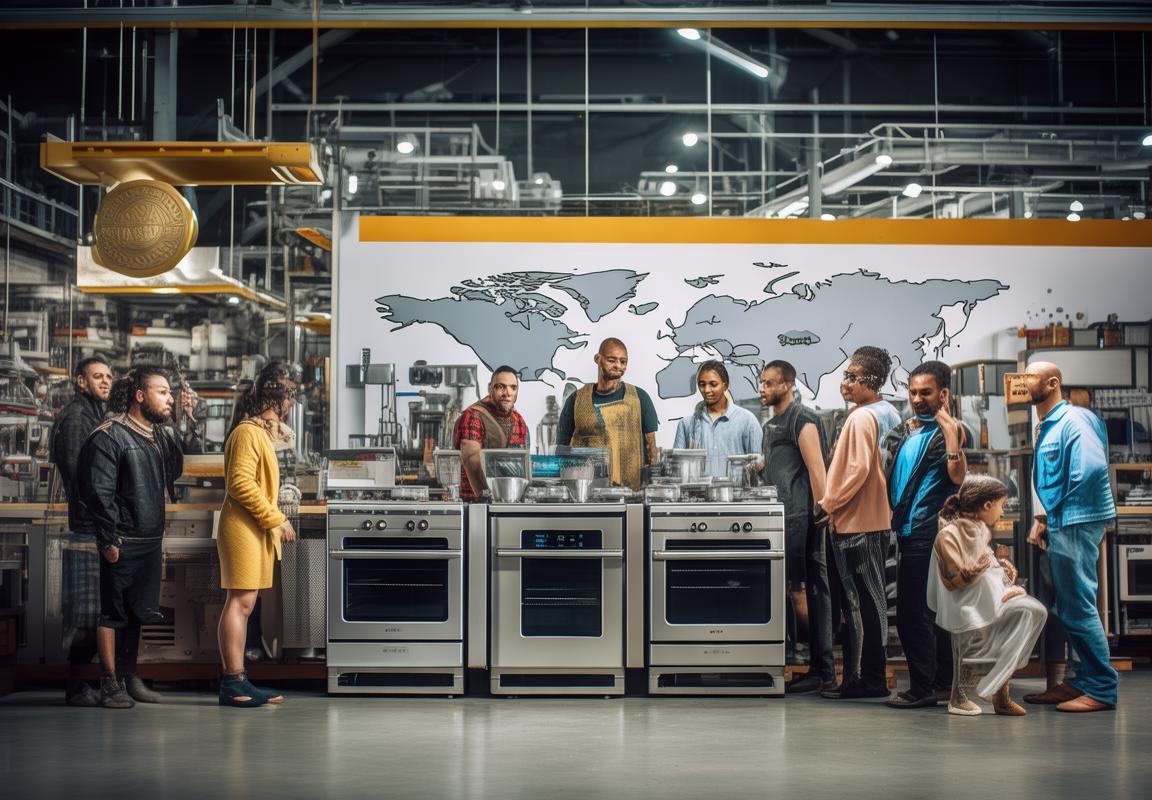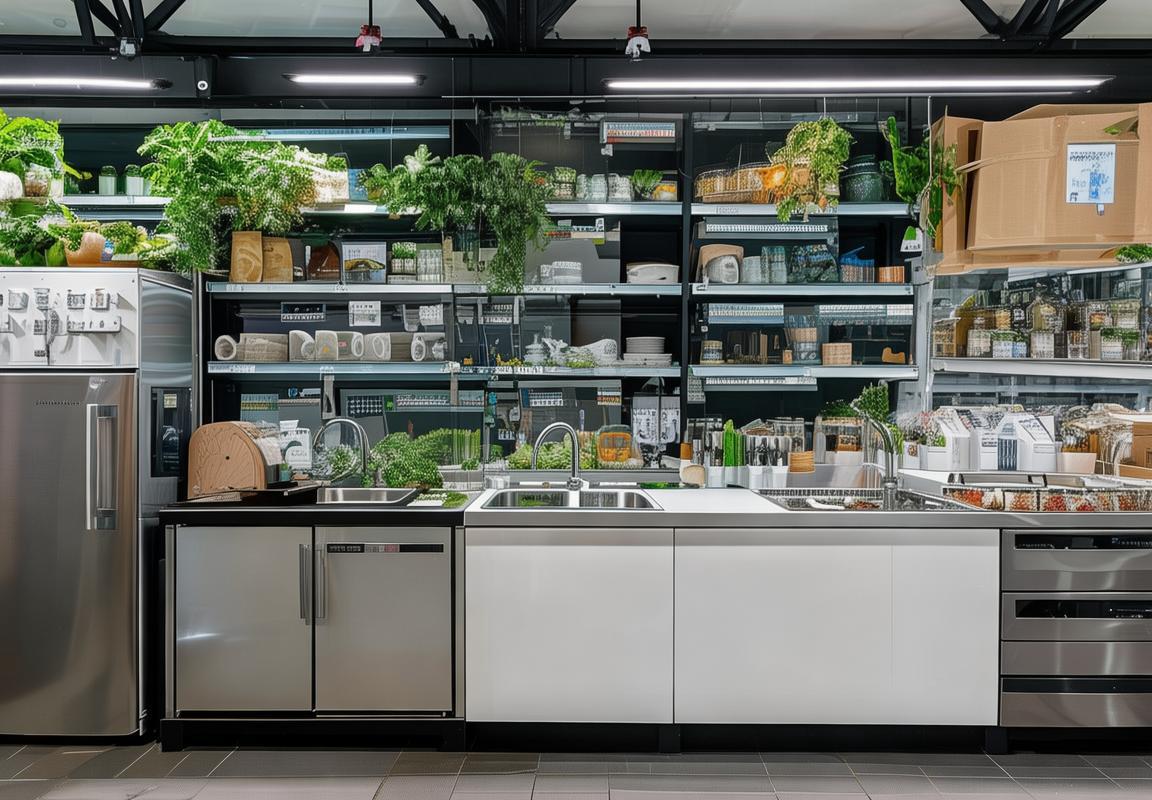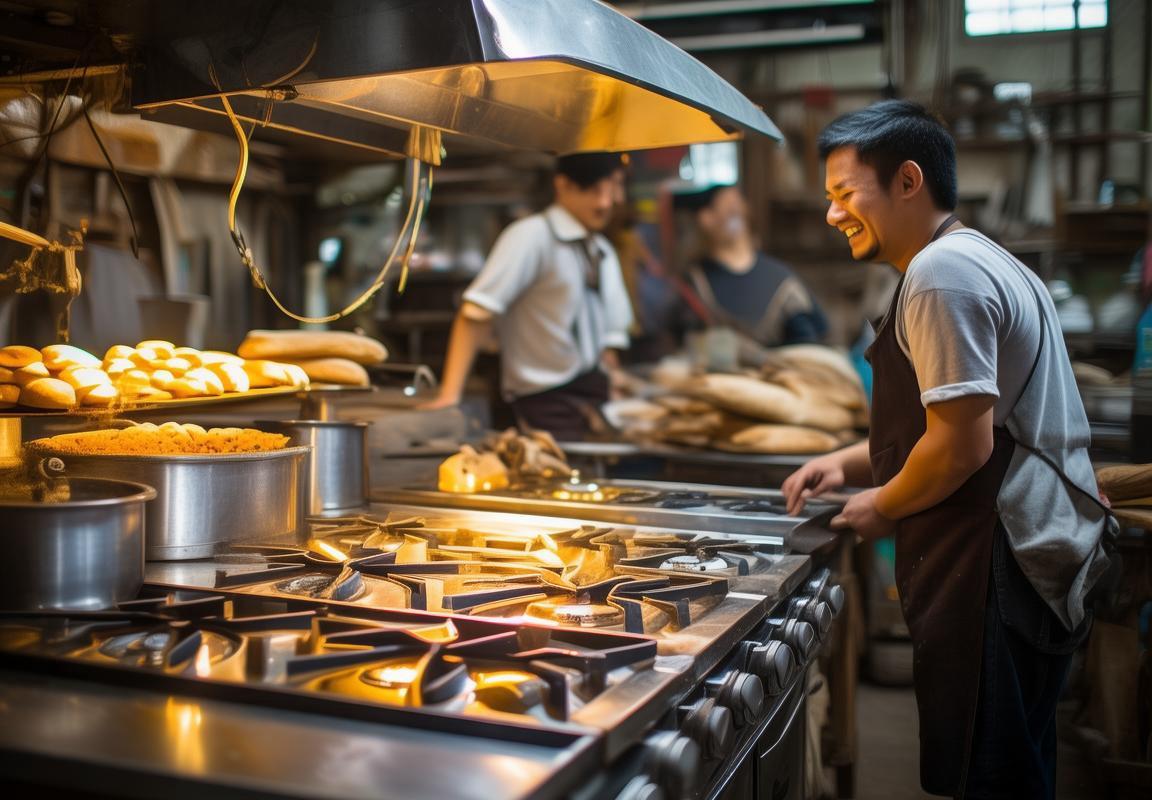In an era marked by global economic fluctuations and supply chain complexities, the concept of import substitution has gained renewed interest across various industries. This trend, particularly pertinent in the kitchen appliance sector, reflects a strategic shift towards fostering domestic production and reducing reliance on foreign suppliers. The reasons behind this shift are multifaceted, ranging from economic security to technological advancements and changing consumer preferences. As we delve into the intricacies of import substitution in kitchen appliances, it becomes evident that this approach is not just a temporary measure but a potential game-changer for the industry.
I.IntroductiontoImportSubstitutioninKitchenAppliances
Import substitution in the kitchen appliance industry refers to a strategic approach where countries aim to reduce their dependence on imported goods by fostering the development of domestic manufacturing capabilities. This concept has gained significant traction in recent years, particularly in the European and American markets, as they grapple with the complexities of global supply chains and the desire to enhance economic self-sufficiency. Let’s delve into the nuances of this phenomenon.
The concept of import substitution is not new, but its application in the kitchen appliance sector is a relatively recent development. Historically, countries have implemented import substitution programs to protect local industries, create jobs, and stimulate economic growth. In the context of kitchen appliances, this means encouraging the production of domestic refrigerators, dishwashers, ovens, and other kitchen gadgets, rather than relying on imports from overseas manufacturers.
One of the primary reasons for the resurgence of import substitution in kitchen appliances is the fragility of global supply chains. Events such as trade disputes, political instability, and natural disasters can disrupt the flow of goods across borders, leaving consumers and businesses alike vulnerable to shortages and price volatility. By developing a robust domestic kitchen appliance industry, European and American markets can insulate themselves from such external shocks.
Economic incentives play a crucial role in driving import substitution programs. Governments often provide subsidies, tax breaks, and other financial incentives to domestic manufacturers to help them compete with established international players. These incentives can lower production costs, improve efficiency, and enhance the quality of domestically produced appliances, making them more attractive to consumers.
Consumer preferences also contribute to the growth of import substitution. There is a growing trend among consumers to support local businesses and products, which can be attributed to factors such as environmental concerns, the desire for unique and culturally relevant designs, and a sense of community. As a result, domestic kitchen appliance brands are increasingly appealing to consumers who are willing to pay a premium for locally made products.
In Europe, the kitchen appliance market has seen a variety of dynamics that have spurred the need for import substitution. The region’s diverse economies and cultural backgrounds have led to a demand for a wide range of products, from energy-efficient appliances in Germany to high-end Italian kitchenware. European manufacturers are capitalizing on these preferences by investing in research and development to create innovative and sustainable solutions.
Similarly, the American kitchen appliance market has its own set of unique characteristics. The U.S. consumer base is vast and varied, with preferences ranging from traditional to modern, and from eco-friendly to high-tech. American manufacturers are leveraging their deep understanding of these preferences to develop appliances that cater to the diverse needs of their customers.
Despite the advantages of import substitution, there are challenges and risks that must be addressed. One of the main concerns is the potential for market inefficiencies. Protecting domestic industries through trade barriers and subsidies can lead to higher prices for consumers and reduced competition, which may ultimately hinder innovation and quality.
Balancing domestic production with global competition is another significant challenge. While import substitution aims to reduce reliance on foreign suppliers, it also needs to ensure that domestic manufacturers can compete on a global scale. This requires investing in advanced technologies, skilled labor, and continuous improvement in product design and manufacturing processes.
Furthermore, there is a risk of over-reliance on domestic suppliers. While import substitution can provide a sense of security in the face of global disruptions, it also means that countries may become vulnerable to internal supply chain issues. Ensuring a diverse and resilient supply base is essential to mitigate this risk.
In conclusion, import substitution in the kitchen appliance industry is a complex and multifaceted strategy that requires careful consideration of economic, political, and consumer factors. By fostering domestic manufacturing, European and American markets can achieve a balance between self-sufficiency and global competitiveness, ultimately leading to a more resilient and sustainable kitchen appliance sector.

II.TheNeedforImportSubstitutioninKitchenAppliances
In the wake of global economic shifts and supply chain disruptions, the need for import substitution in the kitchen appliance market has become increasingly apparent. These appliances, from refrigerators to dishwashers, are not just everyday items; they are integral to modern living. Here’s why the push towards domestic production is gaining traction:
The kitchen appliance industry has long been dominated by international brands, offering a wide range of high-quality products. However, recent events have exposed vulnerabilities in this global supply chain. From trade disputes to pandemics, the reliance on imports has left consumers and businesses alike vulnerable to sudden disruptions.
Economic uncertainties have led to a heightened demand for self-sufficiency in various sectors, including kitchen appliances. Consumers are now more inclined to support local manufacturers, recognizing the importance of a stable domestic market. This shift in consumer sentiment has fueled the need for import substitution programs.
Government policies have also played a significant role in promoting import substitution. In response to the global economic challenges, many European and American governments have introduced incentives and subsidies to encourage domestic production. These measures are designed to bolster local industries, create jobs, and reduce dependence on foreign suppliers.
Moreover, the cost of importing kitchen appliances has been on the rise, driven by factors such as tariffs and transportation expenses. This has made domestically produced appliances more attractive in terms of price and availability. As a result, there is a growing preference for locally manufactured goods, further reinforcing the need for import substitution.
The environmental impact of importing goods from overseas cannot be overlooked. Shipping appliances across the globe contributes to carbon emissions and environmental degradation. By focusing on domestic production, manufacturers can reduce their carbon footprint and contribute to a more sustainable future.
In addition to economic and environmental benefits, import substitution programs can lead to significant improvements in product quality and customization. Local manufacturers have a better understanding of consumer needs and preferences, allowing them to produce appliances that are tailored to the specific requirements of their market.
Another critical factor is the potential for innovation. When manufacturers are not constrained by international competition, they are more likely to invest in research and development. This can lead to the creation of new technologies and products that are unique to the domestic market.
Furthermore, the global supply chain disruptions have highlighted the importance of having a robust domestic supply network. This is particularly relevant in the kitchen appliance industry, where timely delivery of parts and components is crucial for production. By fostering local production, businesses can ensure a more reliable and efficient supply chain.
Despite the numerous benefits, there are challenges associated with import substitution. For instance, domestic manufacturers may struggle to compete with established international brands in terms of quality and brand recognition. Additionally, the transition to domestic production can be costly and time-consuming.
However, the potential rewards outweigh the risks. By investing in domestic production, kitchen appliance manufacturers can create a more resilient industry that is better equipped to withstand future disruptions. This not only ensures a stable supply of appliances for consumers but also supports the economic well-being of local communities.
In conclusion, the need for import substitution in the kitchen appliance market is driven by economic, environmental, and consumer factors. As the global landscape continues to evolve, the emphasis on domestic production is likely to grow, leading to a more robust and sustainable industry.

III.KeyFactorsDrivingImportSubstitutionPrograms
The push for import substitution in the kitchen appliance industry is driven by a complex interplay of factors, each with its own significance. Here’s an exploration of these key drivers:
Economic incentives play a crucial role in encouraging domestic production. As countries seek to reduce trade deficits and bolster their economies, offering subsidies and tax breaks to local manufacturers can be a powerful motivator. These incentives can help offset the higher costs associated with establishing and maintaining domestic production facilities.
Government policies and subsidies are another pivotal force. Many governments recognize the strategic importance of having a robust domestic manufacturing base. They implement policies that protect local industries from foreign competition, such as tariffs, quotas, and import restrictions. Additionally, subsidies can help bridge the gap between the costs of production and the market price, making it more feasible for domestic companies to compete.
Consumer preference shifts are a subtle yet potent driver of import substitution. As consumers become more aware of the environmental and social impacts of their purchases, they often prefer to buy locally produced goods. This preference is not just about supporting local businesses but also about the perceived quality, safety, and sustainability of domestic products.
Technological advancements can also drive import substitution. As local manufacturers invest in research and development, they can develop innovative products that meet or exceed the quality of imported goods. This technological leap can make domestic appliances more attractive to consumers, reducing the demand for foreign imports.
The rise of e-commerce has democratized access to information and products, but it has also created opportunities for import substitution. Local manufacturers can now reach a wider audience more efficiently, bypassing traditional distribution channels. This direct-to-consumer approach can help build brand loyalty and reduce reliance on imported appliances.
Global supply chain disruptions have become a stark reality in recent years. Events like the COVID-19 pandemic have highlighted the vulnerabilities of long-distance supply chains. As a result, companies are seeking to diversify their suppliers and reduce their exposure to such risks. Import substitution can provide a more stable and reliable source of supply.
The need for energy independence is another factor influencing import substitution. Countries with abundant natural resources may look to develop domestic manufacturing capabilities to reduce their dependence on foreign energy sources and materials. This can be particularly relevant in the kitchen appliance industry, where energy-efficient products are in high demand.
The desire for product customization is on the rise, and local manufacturers can often provide more tailored solutions than their international counterparts. As consumers seek appliances that fit their specific needs and preferences, domestic producers can offer a wider range of options, driving demand for locally made appliances.
Lastly, the global trend towards sustainability is a significant driver of import substitution. Kitchen appliances that are energy-efficient, made from recycled materials, and designed for longevity are becoming increasingly popular. Local manufacturers can often respond more quickly to these market demands, fostering a preference for domestic products over imported ones.
These factors, among others, contribute to the growing trend of import substitution in the kitchen appliance industry. As companies and governments recognize the value of local manufacturing, the landscape of the industry is likely to continue evolving, with a greater emphasis on domestic production and innovation.

IV.EuropeanKitchenApplianceMarketDynamics
The European kitchen appliance market has undergone significant transformations, reflecting a blend of technological advancements, shifting consumer preferences, and economic factors. This dynamic landscape is shaped by several key elements:
Innovation in Design and FunctionalityModern European kitchens are characterized by sleek designs and cutting-edge technology. Brands are constantly pushing the boundaries with innovative features such as smart connectivity, energy efficiency, and customizable interfaces. This push for innovation has spurred the need for domestic production to keep pace with these trends.
Economic Shifts and Trade PoliciesThe economic landscape in Europe has seen fluctuations that impact the kitchen appliance market. Changes in trade policies, such as tariffs and import quotas, have influenced the availability and cost of foreign appliances. Additionally, economic shifts like the Eurozone crisis have prompted a reevaluation of domestic production capabilities and the importance of self-sufficiency.
Consumer Trends and SustainabilityConsumers in Europe are increasingly valuing sustainability and ethical production. This has led to a rise in demand for appliances that are not only energy-efficient but also produced with environmentally friendly materials. The market dynamics are shifting to cater to these eco-conscious consumers, often favoring locally manufactured products over imported ones.
Regional Diversity and CustomizationEurope’s diverse range of cultures and climates means that kitchen appliances must often be tailored to specific needs. From the chillers in Mediterranean countries to the powerful freezers in Scandinavian homes, the market demands a variety of solutions. This regional diversity has fueled the growth of domestic manufacturers who can offer customized products.
Rising Cost of ImportsThe cost of importing kitchen appliances has been on the rise due to factors like transportation costs, currency fluctuations, and increased demand for certain models. As a result, domestic manufacturers are finding it more competitive to produce locally, reducing the price gap between local and imported products.
Government Support and IncentivesEuropean governments have recognized the importance of the kitchen appliance industry and have been proactive in supporting domestic manufacturers. Through various incentives, subsidies, and grants, governments are encouraging innovation and the expansion of local production capabilities.
Global Supply Chain DisruptionsRecent global events, such as the COVID-19 pandemic, have highlighted the vulnerabilities of international supply chains. The disruption in the flow of goods has led to delays and increased costs, making it more attractive for European consumers to opt for locally produced appliances that can be delivered more quickly and reliably.
Emerging Markets and Export OpportunitiesWhile the European market is mature, there are opportunities for domestic kitchen appliance manufacturers to expand into emerging markets. As these markets grow, European brands with a reputation for quality and innovation are well-positioned to capture new customers.
Digital Transformation and Online SalesThe digital transformation of the retail landscape has had a profound impact on the kitchen appliance market. Online sales have become a significant channel, and manufacturers are adapting their strategies to leverage e-commerce platforms. This shift has also opened up new markets and customer segments.
Energy Efficiency and Regulatory ComplianceEnergy efficiency has become a critical factor in the European kitchen appliance market. Regulations like the Energy Label Directive have set stringent standards for energy consumption, pushing manufacturers to innovate and improve their products. Compliance with these regulations is not only a legal requirement but also a competitive advantage.
The European kitchen appliance market is a complex tapestry of innovation, consumer demand, and economic factors. As the market continues to evolve, the importance of domestic production and the ability to adapt to changing circumstances will be key to success.

V.AmericanKitchenApplianceMarketTrends
In the wake of shifting global trade dynamics and rising consumer preferences, the American kitchen appliance market is experiencing a transformation that’s being shaped by several key trends. These trends reflect both the current state of the market and its potential for growth and innovation.
The rise of smart appliances has been a significant driver in the American kitchen appliance market. Consumers are increasingly seeking connectivity and control over their kitchen devices, leading to a surge in sales of smart ovens, refrigerators, and dishwashers. These appliances often come with features like voice control, energy monitoring, and the ability to integrate with other smart home systems.
Energy efficiency remains a top priority for American consumers, and this focus is evident in the market’s preference for appliances that are ENERGY STAR certified. Manufacturers are responding by offering a wide range of energy-saving options, from induction cooktops that reduce cooking times to LED lighting in appliances, which not only save energy but also last longer than traditional bulbs.
Sustainability and eco-friendliness are not just buzzwords; they are tangible market forces. Americans are more environmentally conscious than ever, and this has influenced their purchasing decisions. Appliance companies are capitalizing on this trend by introducing models made with recycled materials, energy-efficient designs, and those that can be easily recycled or composted at the end of their lifespan.
Customization is also playing a pivotal role in the American kitchen appliance market. As homeowners invest more in their kitchen spaces, they are looking for appliances that not only perform well but also fit their specific style and design needs. Brands are offering a variety of finishes, colors, and sizes to cater to these preferences, from sleek stainless steel to retro designs that harken back to classic appliances.
The commercial kitchen appliance segment is experiencing growth, driven by the rise of foodservice businesses and the demand for commercial-grade appliances in residential settings. High-end restaurants and gourmet home chefs are looking for professional-grade equipment that can handle the rigors of constant use and precise cooking requirements.
The market is also witnessing a shift in consumer demographics. There is a growing trend among younger homeowners who are more tech-savvy and value innovation and design. These consumers are often more willing to invest in premium appliances that offer the latest technology and aesthetics.
Retail channels continue to evolve, with a mix of traditional brick-and-mortar stores and online retailers driving the market. Online sales have seen significant growth, particularly for high-tech appliances that require less hands-on guidance from sales associates. This shift has prompted manufacturers to focus on digital marketing and improve the online shopping experience to compete effectively.
The integration of kitchen appliances with other home technology is another trend. Brands are exploring ways to integrate their appliances with home automation systems, allowing for seamless control and operation through smart home hubs. This integration can lead to more efficient kitchen use and can also provide homeowners with data-driven insights into their energy consumption and food storage.
Lastly, the economic climate plays a role in shaping market trends. During periods of economic uncertainty, consumers may prioritize spending on long-term investments that enhance their quality of life, such as high-quality kitchen appliances. Conversely, in times of economic growth, there may be a surge in spending on luxury appliances and upgrades.
These trends in the American kitchen appliance market reflect a complex interplay of technological advancements, consumer behavior, and economic factors. As the market continues to evolve, it will be interesting to see how manufacturers adapt and innovate to meet the changing demands of American consumers.

VI.BenefitsofImportSubstitutionPrograms
The benefits of import substitution programs in the kitchen appliance industry are multifaceted, impacting various aspects of both economic and consumer life. Here’s a detailed exploration of these advantages:
Increased Economic Resilience– Domestic manufacturing fosters resilience against global economic shifts and disruptions.- Companies can adapt quickly to market demands and changes in consumer preferences.- A reduced dependency on international suppliers lessens the risk of supply chain disruptions.
Job Creation and Economic Development– Import substitution leads to the growth of domestic manufacturing sectors, creating new job opportunities.- The rise in domestic production can attract skilled labor, boosting local employment rates.- This, in turn, can lead to a multiplier effect, with increased spending stimulating local businesses and services.
Enhanced Domestic Supply Chain– Developing local supply chains for kitchen appliances can lead to improved reliability and efficiency.- By sourcing components domestically, manufacturers can reduce lead times and improve product customization.- This also encourages innovation, as local suppliers may develop specialized parts or technologies tailored to local needs.
Improved Product Quality and Customization– Local manufacturers may better understand and cater to the specific needs and preferences of their domestic market.- This can result in products that are more suited to local conditions, such as energy efficiency or specific design features.- Customers may experience better customer service and after-sales support from domestic companies.
Reduced Imports and Trade Imbalances– By reducing the import of kitchen appliances, countries can decrease their trade deficits.- This can help maintain a more balanced trade relationship with foreign partners.- Import substitution can also lead to a more equitable distribution of wealth within a country.
Stability in the Kitchen Appliance Market– Domestic production can ensure a steady supply of kitchen appliances, reducing price volatility.- This stability can benefit retailers and consumers by providing more predictable pricing and availability.- In times of crisis, domestic production can prevent shortages that might occur if reliant on international suppliers.
Consumer Support and National Pride– Import substitution programs can foster a sense of national pride and support for domestic products.- Consumers may feel more confident purchasing locally-made appliances, contributing to the growth of domestic brands.- This support can create a positive cycle of domestic consumption and investment in local manufacturing.
Long-term Sustainability and Environmental Impact– Domestic manufacturing often aligns with more sustainable practices, as local production can reduce transportation emissions.- Local manufacturers may be more committed to recycling and waste reduction programs.- Import substitution can also encourage the development of eco-friendly kitchen appliances, catering to the growing demand for sustainability.
Innovation and Technological Advancement– Local manufacturers may be motivated to innovate due to increased competition within the domestic market.- The push for innovation can lead to the development of new technologies and design improvements in kitchen appliances.- This can position the country as a leader in appliance technology and design.
ConclusionThe benefits of import substitution programs in the kitchen appliance industry are clear, offering a range of economic, social, and environmental advantages. By promoting domestic production and supporting local businesses, these programs can contribute to the overall growth and sustainability of the kitchen appliance market.

VII.ChallengesandRisksofImportSubstitution
Navigating the complexities of import substitution in the kitchen appliance industry is fraught with challenges and risks that must be carefully managed. Here’s an exploration of some of the key hurdles and potential pitfalls:
The potential for market inefficiencies can arise when domestic production scales up rapidly. Overcapacity can lead to a glut of goods, which may drive down prices and undermine the profitability of local manufacturers. This can happen if the industry does not effectively manage supply and demand, leading to a situation where the market is saturated with appliances that may not all be needed.
Balancing domestic production with global competition is a delicate dance. While import substitution aims to reduce reliance on foreign suppliers, it also requires that domestic companies remain competitive on a global scale. This means investing in technology, innovation, and quality control to meet both domestic and international standards, which can be a significant financial and operational challenge.
Over-reliance on domestic suppliers can create vulnerabilities in the supply chain. If a domestic manufacturer experiences a disruption, such as a factory closure or a shortage of raw materials, it can have a ripple effect throughout the market. This risk is heightened when the industry is heavily concentrated in a few key players, leaving consumers and retailers with limited options during times of need.
The risk of protectionism can also emerge as a result of import substitution programs. While these programs are often designed to shield domestic industries from foreign competition, they can inadvertently raise trade barriers and lead to retaliatory measures from other countries. This can harm the broader economy and potentially lead to trade wars that could impact the entire kitchen appliance sector.
Adapting to changing consumer preferences is another challenge. As markets evolve, so do consumer tastes and needs. Domestic manufacturers must be agile enough to pivot and respond to these changes, which can be difficult when they are focused on meeting the demands of a specific domestic market.
The cost of import substitution can be substantial. Funding research and development, investing in new technologies, and expanding production capabilities all require significant capital. This financial burden can be especially heavy for smaller or newer companies that may not have the resources to compete with established international brands.
Environmental and social considerations can also pose challenges. As domestic production increases, so does the environmental impact, including the consumption of resources and the generation of waste. Additionally, there may be social implications related to labor practices, such as the potential for exploitation if workers are underpaid or overworked to meet production targets.
The complexity of regulatory compliance is yet another risk. Different countries have varying regulations and standards for kitchen appliances, which can make it difficult for domestic manufacturers to expand their operations beyond their home market. Ensuring compliance with these diverse regulations can be time-consuming and costly.
Lastly, the potential for market saturation must be considered. As more domestic companies enter the market to capitalize on import substitution, there’s a risk that the market could become oversaturated with similar products. This could lead to a decrease in product differentiation and a focus on price competition, which may not be sustainable in the long term.

VIII.TheFutureofImportSubstitutioninKitchenAppliances
In the ever-evolving landscape of the kitchen appliance market, the future of import substitution holds both promise and challenges. As the industry continues to adapt to shifting consumer demands and global economic dynamics, several key trends and considerations emerge.
The integration of smart technology is reshaping the kitchen appliance market, with a growing emphasis on connectivity and automation. This shift presents opportunities for domestic manufacturers to innovate and capture a larger share of the market by integrating advanced features and local customization. However, it also requires a significant investment in research and development, which can be a barrier for smaller domestic players.
Sustainability and eco-friendly practices are becoming increasingly important in the kitchen appliance industry. Consumers are more conscious of their environmental footprint and are seeking appliances that are energy-efficient and made with sustainable materials. Import substitution programs can play a crucial role in fostering domestic production of such environmentally friendly appliances, but it must be balanced with the need for global sourcing of certain rare or advanced materials.
The globalization of the kitchen appliance market has led to a more diverse range of products and designs. Domestic manufacturers looking to capitalize on import substitution must understand these global trends and adapt their offerings accordingly. This could mean focusing on niche markets or creating products that cater to specific cultural preferences, which can be a complex and resource-intensive process.
Regulatory changes and trade policies can significantly impact the future of import substitution in the kitchen appliance sector. Tariffs, trade agreements, and environmental regulations can either create barriers to foreign imports or open doors for domestic production. Domestic manufacturers must stay vigilant and flexible to these changes, ensuring they can respond quickly to shifts in the market.
The rise of e-commerce and direct-to-consumer sales models has the potential to disrupt traditional distribution channels. Import substitution programs can leverage these digital platforms to reach a wider audience and bypass traditional retail middlemen. This direct engagement can enhance customer relationships and improve market responsiveness, but it also requires a strong online presence and digital marketing expertise.
Technological advancements, particularly in robotics and artificial intelligence, are poised to revolutionize the manufacturing process. Automation can lead to increased efficiency and reduced costs, which can be a significant advantage for domestic producers aiming to compete with international brands. However, the integration of these technologies demands substantial upfront investment and ongoing maintenance, which can be daunting for smaller companies.
Consumer behavior is shifting towards a preference for locally made products, driven by factors such as perceived quality, ethical manufacturing practices, and support for local economies. This trend aligns with the goals of import substitution programs, but it also requires domestic manufacturers to maintain high standards and offer competitive pricing to attract and retain customers.
The future of import substitution in the kitchen appliance market is not without its risks. Economic downturns can lead to reduced consumer spending on non-essential items like kitchen appliances. Additionally, over-reliance on domestic production can limit access to the latest global innovations and technology, potentially slowing down the pace of innovation within the market.
In conclusion, the future of import substitution in the kitchen appliance market is multifaceted, requiring a delicate balance between leveraging local resources and maintaining a competitive edge in a globalized world. As the industry continues to evolve, manufacturers must be agile, innovative, and forward-thinking to navigate the challenges and capitalize on the opportunities that lie ahead.

IX.Conclusion
As we delve into the complexities of import substitution in the kitchen appliance industry, it’s clear that the future holds both promise and challenges. The shift towards domestic production isn’t just a trend; it’s a strategic move that could redefine the global market landscape. Here are some key considerations that will shape the future of import substitution in kitchen appliances:
The evolution of technology will play a pivotal role in determining the success of import substitution. As innovation continues to push the boundaries of what’s possible in kitchen appliances, domestic manufacturers will need to keep pace with these advancements to remain competitive. This means investing in research and development to create cutting-edge products that appeal to both domestic and international consumers.
Economic policies and trade agreements will also significantly influence the trajectory of import substitution. Governments that prioritize domestic industry will likely offer incentives, such as tax breaks and grants, to encourage local production. Conversely, stringent trade policies or tariffs could either protect domestic markets or hinder the growth of import substitution programs.
Consumer awareness and preferences will be a driving force behind the success of import substitution. As consumers become more environmentally conscious and value local production, they may actively seek out domestic brands. This shift in consumer behavior could create a virtuous cycle where demand for locally made appliances increases, further driving the growth of domestic manufacturing.
The environmental impact of kitchen appliances cannot be overlooked. As sustainability becomes a key concern for both manufacturers and consumers, the focus on eco-friendly designs and production processes will become more pronounced. Import substitution programs that prioritize green technologies and energy-efficient appliances are likely to gain traction in the market.
The integration of the digital economy will also play a role in the future of import substitution. Smart kitchen appliances that connect to the internet and offer enhanced functionality are becoming increasingly popular. Domestic manufacturers that can leverage digital platforms and technology to create smart kitchen ecosystems may have a competitive edge.
International collaboration and partnerships will be crucial for the success of import substitution programs. By working with foreign companies, domestic manufacturers can gain access to global supply chains, technology, and market insights. This could lead to a win-win situation where both domestic and international companies benefit from the exchange of knowledge and resources.
The role of education and training cannot be overstated. To maintain a competitive edge, domestic manufacturers will need a skilled workforce. Investing in education and vocational training programs to develop a skilled labor force will be essential for the long-term success of import substitution in the kitchen appliance industry.
The future of import substitution in kitchen appliances will also be shaped by the ability of manufacturers to adapt to changing market conditions. As consumer needs evolve and new technologies emerge, companies must be agile and willing to innovate. This adaptability will be key to staying relevant in a rapidly changing industry.
In conclusion, the future of import substitution in the kitchen appliance industry is multifaceted, influenced by a combination of technological advancements, economic policies, consumer preferences, environmental concerns, and international dynamics. As the industry continues to evolve, those who navigate these complexities successfully will be well-positioned to lead the market in the years to come.